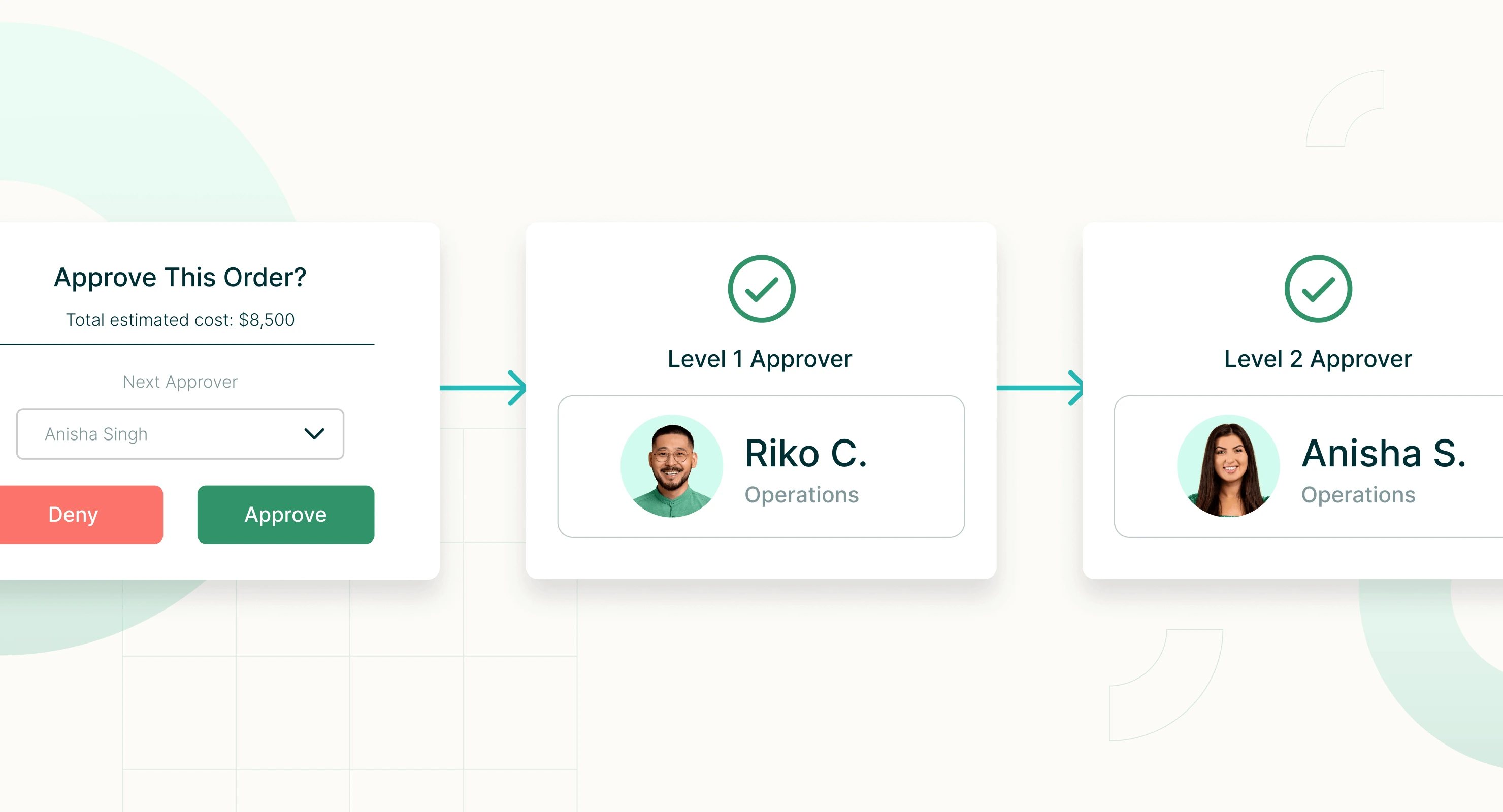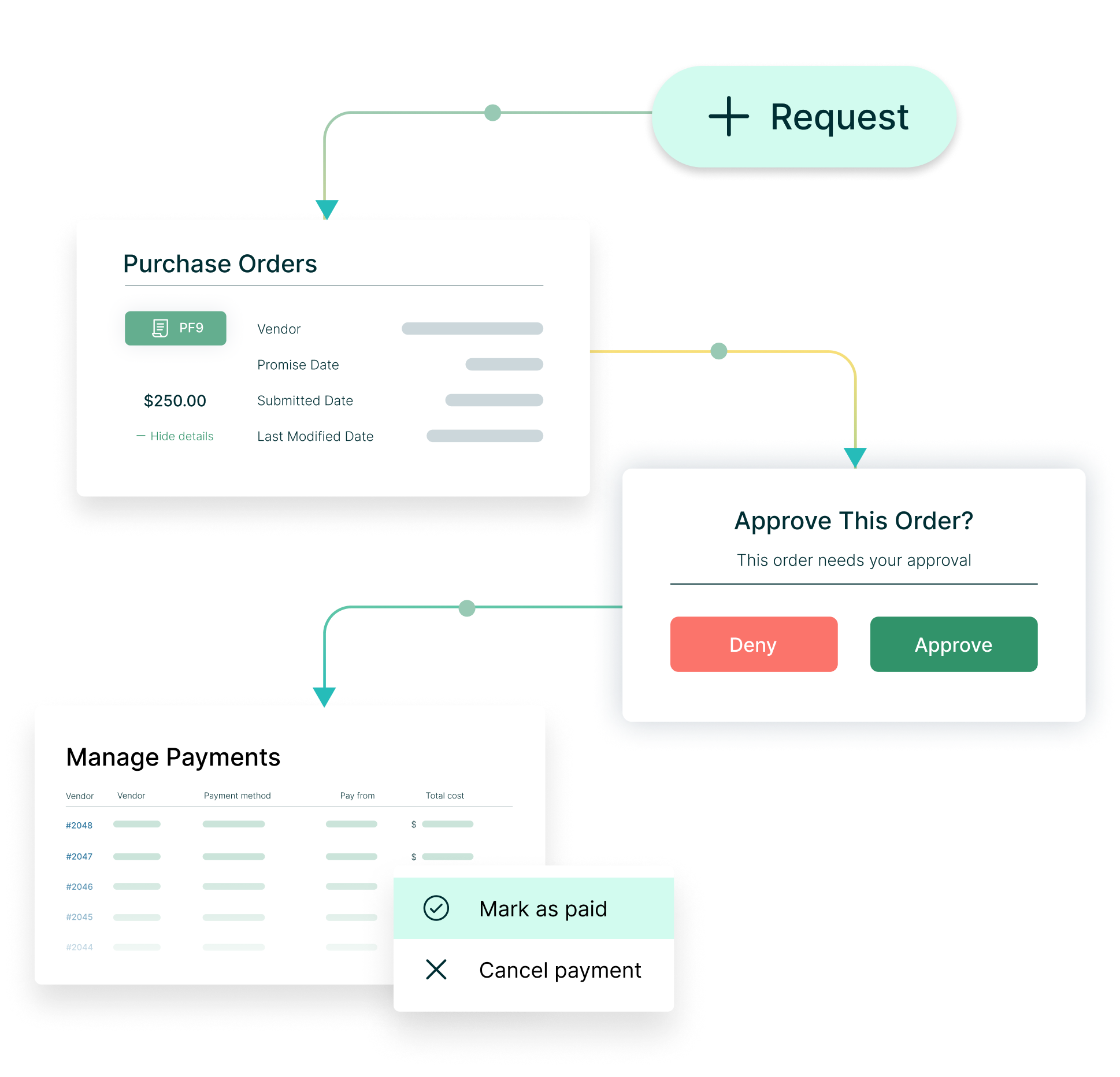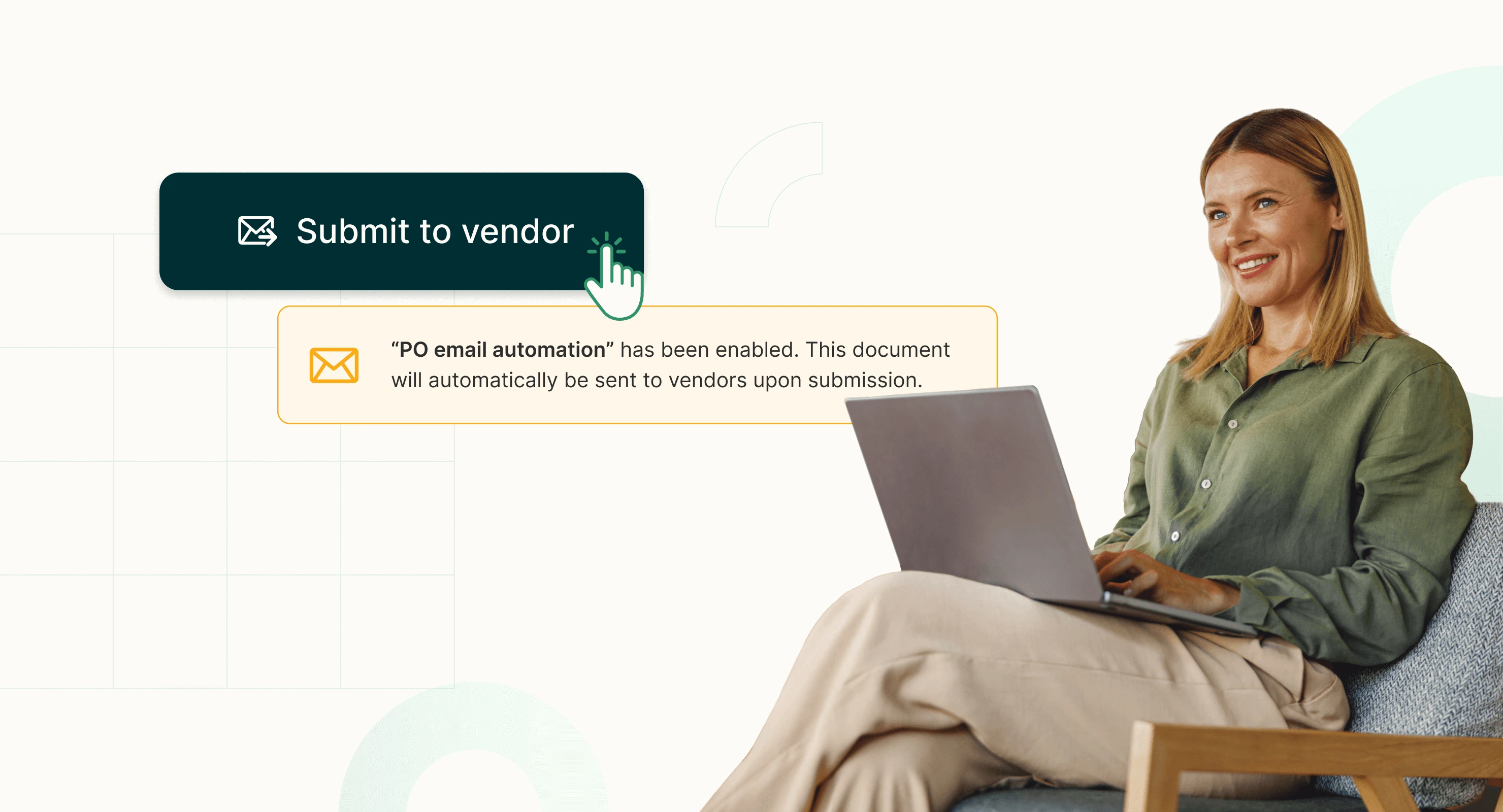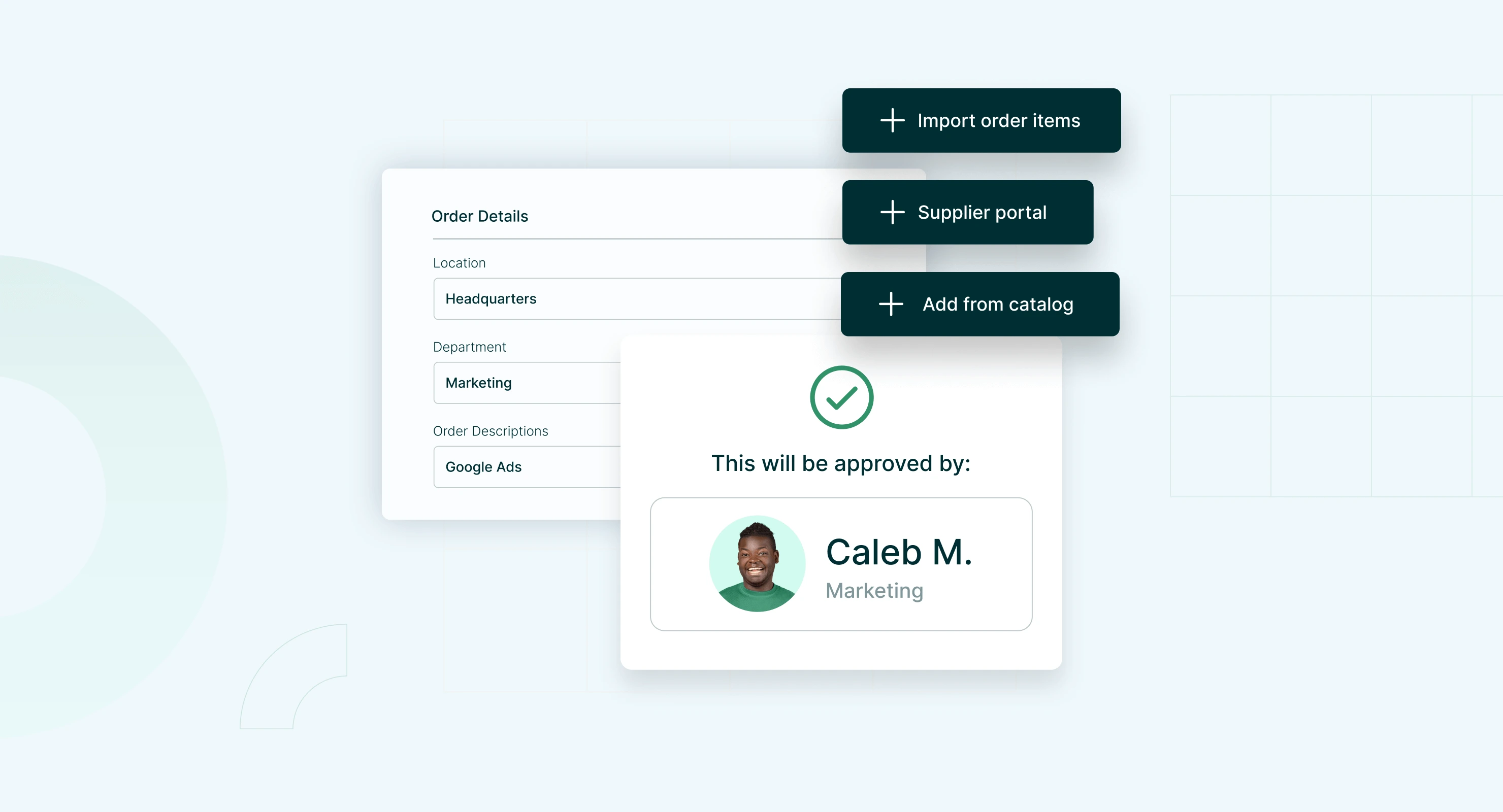
Purchase Approval Workflows: A Comprehensive Guide
In 2024, it is almost mandatory that your procurement process is powered by automation. Whether your organization is purchasing a small requisition for office supplies or a significant expenditure on new equipment, being quick, accurate, and cost-efficient is the name of the game.
Enter purchase approval workflows.
At its core, a purchase approval workflow is designed to streamline purchasing, helping businesses avoid costly errors, unauthorized spending, and delays resulting from manual process bottlenecks.
Managing company spending efficiently is more critical than ever in today’s fast-paced business environment. A purchase approval workflow is a structured process that governs how purchase requests are made, reviewed, and approved, ensuring that organizations maintain control over their budgets and adhere to compliance requirements.

Automate Your Purchase Order Approval Process
Procurify’s procure-to-pay software automates your company’s purchasing workflow from order creation and approvals to invoice payment – to speed up purchasing, improve internal communication, and minimize financial risk.
In this article, we’ll dive deep into the stages of a purchase approval workflow, explore common challenges with traditional processes, and discuss how automating your workflow can increase transparency, compliance, and cost savings for your business.
Key stages of a purchase approval workflow
A well-structured purchase approval workflow is essential for controlling expenses, improving transparency, and ensuring compliance within an organization. The workflow typically consists of several key stages that guide the purchasing process from the initial request to final approval and order creation. Below are the main stages involved in an effective purchase approval process.
-
Request submission
The process begins when an employee or department identifies a need for goods or services. A purchase requisition detailing the specific items, quantities, and estimated costs is submitted. This request might go through a digital system where all necessary details—such as vendor information, price quotes, and delivery timelines—are recorded. Clear documentation is crucial at this stage to avoid delays later in the workflow.
In some organizations, multiple departments may require separate types of requests. For example, IT equipment might have a different requisition form than office supplies, allowing for more precise handling of specialized requests. -
Approval routing
Once the purchase request is submitted, it follows an approval routing process, where the request is reviewed by the necessary stakeholders based on predefined criteria like department, budget thresholds, and the value of the request. Small purchases may only require a manager’s approval, while larger requests might escalate to department heads, procurement teams, or even C-suite executives.
Approval chains can vary from linear workflows, where approvals happen one after another, to parallel workflows, where multiple approvers can review the request simultaneously to reduce delays. Some systems use conditional workflows, where the route depends on specific conditions like the total cost or type of purchase.
-
Budget and compliance checks
One of the most important stages in the workflow is the budget and compliance check. Before a purchase can be approved, the requisition is checked against the available budget to ensure the organization can cover the expense. Additionally, compliance with company policies, vendor agreements, and any legal requirements is verified.
This step is vital for organizations that must adhere to strict financial controls. Without proper checks, rogue spending or over-budget expenditures could impact the company’s financial health. Automation tools help streamline this process by cross-referencing data instantly, reducing the risk of errors.
-
Purchase order creation
Once the request is fully approved, a purchase order (PO) is generated. This document serves as a formal agreement between the organization and the vendor, specifying the items or services to be delivered, pricing, and delivery timelines. The purchase order is then sent to the vendor, who acknowledges and confirms the order.
At this stage, the PO becomes a legally binding document, ensuring that both the organization and the vendor adhere to the terms agreed upon. This formalization helps protect the company from disputes regarding delivery or payment.
-
Receipt and three-way matching
After the purchase order is sent, the organization receives the goods or services. The final stage of the workflow involves three-way matching, a critical accounting process that ensures the purchase order, goods receipt, and vendor invoice all align.
If any discrepancies are found between these documents—such as incorrect quantities or pricing—the issue is flagged for review and resolution before payment is processed. This step ensures accuracy, accountability, and that no unauthorized payments are made.
Common challenges in manual purchase approval workflows
While purchase approval workflows are essential for controlling organizational spending, relying on manual processes can create significant inefficiencies and risks. Manual workflows, which often involve paper forms, emails, and spreadsheets, are prone to delays, errors, and lack transparency. Below are some of the most common challenges businesses face that still rely on manual purchase approval workflows.
Time delays and bottlenecks
One of the primary issues with manual workflows is the time it takes for approvals to move through the process. When approvers are busy or unavailable, purchase requests can sit idle, causing delays in procurement and, ultimately, impacting the organization’s ability to acquire necessary goods and services on time. Manual processes often rely on emails or physical hand-offs between departments, which can create unnecessary bottlenecks, especially when multiple levels of approval are required.
In contrast, automated workflows streamline these steps by notifying approvers in real-time and allowing approvals to be completed from any device, reducing the risk of delays and keeping the procurement process moving smoothly.
Lack of visibility and transparency
In a manual system, tracking the status of a purchase request can be difficult. Employees might not know where their request stands, or whether it has been approved or rejected. Additionally, managers may have trouble accessing a clear, real-time overview of all pending approvals and budgetary impact. This lack of visibility can make it challenging to enforce accountability or ensure that approvals are handled promptly.
Manual workflows are often fragmented, with no centralized system to manage or monitor the entire approval process, making it difficult to ensure compliance with procurement policies.
This issue is exacerbated as organizations grow, making manual tracking systems increasingly unmanageable.
High risk of errors and rogue spending
Errors are much more common in manual workflows. These errors can range from incorrectly entered data to missing approval signatures, leading to mistakes in budgeting and spending. Additionally, manual processes increase the risk of rogue spending—when purchases are made without proper approval or outside of agreed-upon vendor contracts. This type of unauthorized spending can quickly spiral out of control, resulting in financial losses and compliance issues.
Manual workflows also often lack the audit trails necessary to track approvals and spending decisions. Without a proper system for documenting approvals, it becomes difficult to trace who approved a purchase and when it occurred, making it challenging to identify the root causes of issues like overspending or fraudulent purchases.
The benefits of automated purchase approval workflows
Transitioning from manual to automated purchase approval workflows offers a multitude of advantages that can significantly enhance an organization’s procurement process. Automation addresses the challenges inherent in manual systems and introduces new efficiencies and controls that drive better financial management and operational performance. Below are the primary benefits of implementing automated purchase approval workflows.

Speed and efficiency
One of the most significant advantages of automation is the substantial increase in speed and efficiency to the purchase approval process. Automated workflows eliminate the need for manual hand-offs, paperwork, and email chains, which are often time-consuming and prone to delays.
-
Faster processing times: Automated systems can instantly route purchase requests to the appropriate approvers based on predefined rules, significantly reducing the time it takes for approvals to be granted.
-
Real-time notifications: Approvers receive immediate notifications on their devices, enabling them to review and approve requests promptly, even when they are not in the office.
-
Reduced administrative burden: Automation minimizes the need for manual data entry and tracking, allowing procurement teams to focus on more strategic tasks rather than administrative duties.
By streamlining each step of the approval process, organizations can accelerate their procurement cycles, ensuring that necessary goods and services are acquired without unnecessary delays.
Better compliance
Automated purchase approval workflows enhance compliance with organizational policies and regulatory requirements. By embedding compliance checks into the workflow, organizations can ensure that every purchase adheres to established guidelines.
-
Policy enforcement: Automated systems can enforce company policies by ensuring that all purchase requests meet specific criteria before approval. This reduces the likelihood of unauthorized or non-compliant purchases.
-
Consistent approval processes: Automation ensures that every purchase follows the same approval path, maintaining consistency across the organization and reducing the risk of policy violations.
-
Audit trails: Automated workflows automatically generate detailed audit logs that track every action taken during the approval process. These logs provide a transparent record for compliance audits and can help identify deviations from established procedures.
Enhanced compliance safeguards the organization against financial and legal risks and fosters a culture of accountability and transparency.
Cost savings
Automating purchase approval workflows can lead to significant cost savings by minimizing errors, reducing fraud, and optimizing spending.
-
Reduction in errors: Automation minimizes human errors such as incorrect data entry or missed approvals, which can lead to financial discrepancies and increased costs.
-
Fraud prevention: Automated systems include checks and balances that help detect and prevent fraudulent activities, such as unauthorized purchases or duplicate payments.
-
Optimized spending: By providing real-time visibility into spending patterns and budget utilization, automation helps organizations make more informed purchasing decisions, avoiding unnecessary or excessive expenditures.
-
Lower administrative costs: Reducing the time and resources spent on manual processing translates into direct cost savings for the organization.
These cost-saving measures not only improve the bottom line but also allow organizations to allocate resources more effectively.
Transparency and real-time tracking
Automation brings a higher level of transparency and enables real-time tracking of purchase requests throughout the approval process.
-
Centralized data management: All purchase requests and their statuses are stored in a centralized system, making it easy for stakeholders to access and review information at any time.
-
Real-time visibility: Managers and finance teams can monitor the progress of purchase requests in real-time, providing them with up-to-date insights into procurement activities and budget status.
-
Enhanced reporting: Automated workflows offer advanced reporting capabilities, allowing organizations to generate detailed reports on spending, approval times, and compliance metrics. These reports facilitate better decision-making and strategic planning.
-
Stakeholder collaboration: With a transparent system, all relevant parties can collaborate more effectively, ensuring that everyone is informed and aligned throughout the approval process.
Increased transparency not only improves operational efficiency but also builds trust among stakeholders by providing clear and accessible information about procurement activities.
Enhanced user experience
Automated workflows provide a more user-friendly experience for all participants in the approval process.
-
Ease of use: Modern procurement software offers intuitive interfaces that simplify the process of submitting, reviewing, and approving purchase requests.
-
Accessibility: Automated systems are often cloud-based, allowing users to access the workflow from any device with an internet connection. This flexibility supports remote work and ensures that approvals can be handled promptly, regardless of location.
-
Customizable workflows: Organizations can tailor automated workflows to meet their specific needs, ensuring that the system aligns with their unique processes and requirements.
-
Mobile approvals: Many automated systems support mobile approvals, enabling approvers to review and approve requests on the go, further speeding up the process.
A better user experience leads to higher adoption rates, smoother operations, and greater satisfaction among employees and managers involved in the procurement process.
Best practices for implementing and optimizing purchase approval workflows
Implementing a purchase approval workflow is more than just automating a process—it requires careful planning, customization, and continuous optimization to ensure maximum efficiency and compliance. By following best practices, organizations can streamline their approval workflows and ensure that they meet specific operational needs. Below are some key best practices for setting up and optimizing purchase approval workflows.

Pre-defined approval chains
One of the most effective ways to ensure smooth operations is to create pre-defined approval chains that align with the organization’s structure and spend policies. Approval chains should be established based on the department, purchase categories, and the monetary value of requests. This allows organizations to apply different levels of scrutiny to high-value purchases versus everyday operational expenses.
-
Monetary thresholds: Set clear thresholds for different purchase values, where smaller purchases may require only one level of approval, while larger expenditures require multi-level approvals, possibly involving department heads or even the C-suite.
-
Conditional routing: Consider setting up conditional approval chains, where certain purchases automatically follow different paths depending on factors like vendor, purchase amount, or department.
Pre-defined approval chains create consistency across the organization, ensure compliance, and eliminate confusion over who needs to approve what.
Set approval thresholds
Establishing approval thresholds helps speed up the workflow by ensuring that only the necessary approvers are involved based on the scale of the purchase. For example, routine office supplies may only require a manager’s approval, while larger capital expenditures may need additional oversight from the finance team or executive management.
-
Tiered approvals: Create different levels of approval based on purchase size, such as one level for purchases under $1,000, two levels for purchases between $1,000 and $10,000, and three levels for purchases above $10,000.
-
Cross-department collaboration: Ensure approvals are routed to the correct stakeholders within relevant departments, such as procurement, finance, or legal teams, depending on the purchase type and cost.
This practice helps avoid bottlenecks for low-value purchases while maintaining rigorous control over high-value or critical spending.
Leverage automation tools
Automation tools are central to improving the efficiency of purchase approval workflows. These tools allow organizations to customize workflows, streamline approval processes, and ensure compliance.
-
Mobile approvals and notifications: Use automation tools that offer mobile access and real-time notifications to keep approvals moving even when key approvers are out of the office. This helps eliminate delays caused by unavailable approvers.
-
Customizable templates: Utilize software that allows for customizable approval templates based on the type of purchase, department, or vendor. This ensures that the workflow is tailored to the organization’s specific needs.
-
Automated reminders: Set up automated reminders and notifications to prompt approvers when actions are needed. This prevents requests from getting stuck in the system.
Leveraging the right automation tools speeds up the process and ensures that the workflow remains consistent and compliant across all levels of the organization.
Continuous monitoring and optimization
Once a purchase approval workflow is in place, it’s important to continuously monitor its performance and make adjustments as necessary. Regularly reviewing and refining the process can help identify inefficiencies and ensure the workflow adapts to changing organizational needs.
-
Track approval cycle times: Use approval software tools to monitor how long approvals take at each stage. If certain stages consistently cause delays, consider adjusting the workflow to reduce bottlenecks.
-
Audit compliance: Conduct regular workflow audits to ensure compliance with internal policies and external regulations. Automating audit trails makes this process more efficient and transparent.
-
Solicit feedback from stakeholders: Gather input from employees involved in the workflow to identify areas for improvement. Employees who regularly interact with the system can provide valuable insights on how to streamline processes.
By continuously refining the workflow, organizations can optimize procurement processes to maximize efficiency and maintain compliance.
Frequently Asked Questions
When implementing a purchase approval workflow, businesses often have questions about customization, efficiency, and how to optimize the process for their needs. Below are some of the most frequently asked questions (FAQs) and their answers.
Conclusion
Automated purchase approval workflows streamline every stage of the purchase process—from request submission to final approval and purchase order creation. They provide real-time tracking, transparency, and a higher level of accountability for all stakeholders involved. For companies seeking to maintain tighter control over their spending while minimizing the risks of errors and delays, implementing an automated workflow is a smart investment.
A well-structured and automated purchase approval workflow is essential for businesses looking to optimize their procurement process. By moving away from manual systems, organizations can significantly improve efficiency, reduce errors, and gain better visibility into their spending. Automating the purchase approval process speeds up approval times and ensures compliance with company policies and regulatory requirements, leading to cost savings and enhanced operational control.

Webinar: From Reactive to Real-Time Spend Management
Learn why more CFOs are investing in technology and systems that deliver real-time visibility and control over all business spend – to ultimately reduce risk and cut costs.
